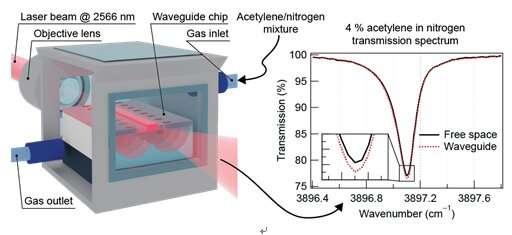Air-guiding in solid-core optical waveguides: A solution for on-chip trace gas spectroscopy

Optical waveguides suspended in air are capable of beating free-space laser beams in light-analyte interaction even without complex dispersion engineering. This phenomenon was predicted more than 20 years ago, yet never observed in experiment.
In a new paper published in Light Science & Applications, a team of scientists, led by Professor Jana Jágerská from Department of Science and Technology, UiT The Arctic University of Norway, and co-workers have devised a mid-infrared free standing solid core optical waveguide which pushes the light interaction with the surrounding air beyond what has been reported up until now: 107 % interaction strength compared to that of a free-space beam has been demonstrated.
"The guided mode of our thin waveguide resembles a free-space beam: it is strongly de-localized and travels predominantly in air. But, at the same time, it is still bound to the chip and can be guided along a pre-defined e.g. spiral waveguide path."
This is a significant achievement from the perspective of basic research but also an important step towards practical applications in on-chip gas sensing. Thanks to the high air-confinement of the guided mode, the waveguide not only improves upon the light-analyte interaction, but the guided light also experiences minimal overlap with the solid waveguide core material. This means that the guided mode is only marginally disturbed by material or structural imperfections, which suppresses undesired loss, scattering or reflections. The waveguide hence delivers transmission nearly free from spurious etalon fringes, which are of utmost importance for applications in trace gas spectroscopy.
"The main killer of precision of TDLAS instruments are [spectral] fringes, and integrated nanophotonic components typically produce plenty of them. Our chips are different. The theoretical reflections on the waveguide facets are as low as 0.1 %, and spurious fringes in transmission are therefore suppressed to below the noise level."
This optical waveguide fits therefore very well into the prospect of a future miniature trace gas sensors. Sensitive and selective integrated sensors based on the reported waveguide chips would not only down scale the dimensions of existing trace gas analysers, but also allow for microlitre sensing volumes and deployment in distributed sensors networks, leading to new applications in environmental monitoring, biology, medicine, as well as industrial process control.
More information: Marek Vlk et al, Extraordinary evanescent field confinement waveguide sensor for mid-infrared trace gas spectroscopy, Light: Science & Applications (2021). DOI: 10.1038/s41377-021-00470-4
Journal information: Light: Science & Applications
Provided by Chinese Academy of Sciences





















